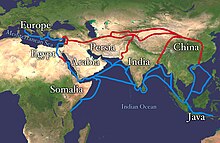Thetaka,also known as thetankaortangka,was one of the major historical currencies ofAsia,particularly in theIndian subcontinentandTibet.It was introduced in the 14th century and became a currency of theSilk Road.Its history is intertwined with the medieval Islamic history and culture of the Indian subcontinent.

In modern times, theBangladeshi takais considered a legacy of the historical taka becauseBengalwas the stronghold of the currency. It was inscribed in numerous languages across different regions, including in Sanskrit, Arabic, Persian, Hindustani, Bengali, Nepali, Tibetan and Mandarin.
Etymology
editAccording toThe American Heritage Dictionary of the English LanguageandBanglapedia,the wordtakacame from theSanskritwordtankah.[1][2]
Introduction in North India
editThe imperial tanka (also called Sultani tanka) was officially introduced by the monetary reforms ofMuhammad bin Tughluq,the emperor of theDelhi Sultanate,in 1329. It was modeled asrepresentative money,a concept pioneered as paper money by theMongolsinChinaandPersia.The tanka was minted in copper and brass. Its value was exchanged with gold and silver reserves in the imperial treasury. The currency was introduced due to the shortage of metals.[3]Over time, the tanka was minted in silver. However, chaos followed its launch in the 14th century, leading to the collapse of theTughluq dynasty.The Tughluqs were succeeded by numerous regional states, notably theBengal Sultanate,theBahmani Sultanateand theGujarat Sultanate.These kingdoms continued to mint the new currency in the name of their own rulers. Even much later under the early modernMughal Empire,regional currencies were still referred to as tanka/tangka/taka.
Arakan
editThe Bengal tanka was widely circulated in theKingdom of Mrauk U(now inMyanmar) in the 16th and 17th centuries, when it was avassal stateof the Bengal Sultanate.
-
Silver tanka from Arakan with Perso-Arabic script
Bangladesh
editTheBangladeshi takais the currency of modernBangladesh.It was officially introduced in 1972 by theBangladesh Bankto replace thePakistani rupeeat par following the end of theBangladesh Liberation Warand is produced by Bangladesh'sSecurity Printing Corporation.The Bangladeshi taka carries the symbols ৳ and Tk.
Bengal
editThe taka was traditionally equal to one silver rupee in Islamic Bengal.[4]In 1338,Ibn Battutanoticed that the silver taka was the most popular currency in the region instead of the Islamicdinar.[5]In 1415, members ofAdmiral Zheng He's entourage also noticed the dominance of the taka. The currency was the most important symbol of sovereignty for theSultan of Bengal.The Sultanate of Bengal established at least 27mintsin provincial capitals across the kingdom.[6][7]
The taka continued to be issued inMughal Bengal,which inherited the sultanate's legacy. As Bengal became more prosperous and integrated into theworld economyunder Mughal rule, the taka replaced shell currency in rural areas and became the standardizedlegal tender.It was also used in commerce with theDutch East India Company,theFrench East India Company,theDanish East India Companyand theBritish East India Company.
-
Silver taka ofRaja GaneshawithBengaliscript
-
Silver taka ofJalaluddin Muhammad ShahwithArabicscript and a lion symbol
East India
editIn 14th-centuryOdisha,epigraphic records use terms such asvendi-tanka(alloyed silver) andsasukani-tanka(bullion). The tanka spread to the region from theDelhi Sultanate.[8]
Nepal
editThe tanka standard was introduced in the prosperous HimalayanKathmandu Valley(Nepal proper) in the 16th century. It was modeled on the currency of Delhi, Bengal and the Mughal Empire. The Nepalese tanka was a debased silver coin struck in 10 g. weight with minor denominations of 1⁄4, 1⁄32, 1⁄123, 1⁄512. It was introduced by King Indra Simha.[9]
Pakistan
editUntil 1971, the present-dayPakistani rupeehad bilingual inscriptions in Urdu and Bengali, and was called both the rupee and taka. TheBengali Language Movementplayed a decisive role in ensuring the recognition of the taka inEast Pakistan.
-
A Pakistani banknote with Bengali script denoting 10 taka
South India
editThe tanka was widely minted in theDeccan,including theDeccan sultanatesand Mughal provinces. In theBerar SultanateandBerar Subah,one Tanka-i-Barari was equal to eight Delhi tankas.
Tibet
editTheTibetan tangkawas an official currency of Tibet for three centuries. It was introduced byLhasa Newarmerchants from Nepal in the 16th century. The merchants used Nepalese tanka on theSilk Road.The Tibetan government began to mint the tangka in the 18th century. The first Tibetan tangka was minted in 1763/64. China'sQing dynasty,Tibet's suzerain,[citation needed]established mints in the region in 1792.[citation needed]The Sino-Tibetan tangka carriedChinese languageinscriptions.[10]
Banknotes were issued between 1912 and 1941 in denominations of 5, 10, 15, 25 and 50 tangka.
-
Tibetan tangka minted by theQing dynasty
-
Tibetan tangka in Ranjana script
-
The Gaden tangka, which was used until 1948
West India
editIn the 15th century, theGujarat Sultanate,on the west coast of the Indian subcontinent, began to mint silver tanka. It was a symbol of sovereignty for theMuzaffarid dynasty of Gujarat.
-
Silver tanka in Perso-Arabic script (Nasiruddin Mahmud Shah I reign)
-
Silver tanka in Perso-Arabic script (Ahmad Shah reign)
-
Early copper tanka
See also
editReferences
edit- ^Company, Houghton Mifflin Harcourt Publishing."The American Heritage Dictionary entry: taka".www.ahdictionary.com.Archivedfrom the original on 2022-03-31.Retrieved2019-06-02.
- ^"Taka".en.banglapedia.org.Archivedfrom the original on 2020-01-16.Retrieved2017-02-14.
- ^Shoaib Daniyal."History revisited: How Tughlaq's currency change led to chaos in 14th century India".scroll.in.Archivedfrom the original on 2017-02-15.Retrieved2017-02-14.
- ^"Taka – Banglapedia".en.banglapedia.org.Archivedfrom the original on 2020-01-16.Retrieved2017-02-14.
- ^Ian Blanchard (2005).Mining, Metallurgy and Minting in the Middle Ages: Continuing Afo-European supremacy, 1250–1450.Franz Steiner Verlag. p. 1264.ISBN978-3-515-08704-9.
- ^"Coins – Banglapedia".en.banglapedia.org.Archivedfrom the original on 2020-11-13.Retrieved2017-02-14.
- ^"Currency System – Banglapedia".en.banglapedia.org.Archivedfrom the original on 2017-02-15.Retrieved2017-02-14.
- ^Nihar Ranjan Patnaik (1997).Economic History of Orissa.Indus Publishing. p. 101.ISBN978-81-7387-075-0.
- ^Joshi, Satya Mohan(1961).Nepali Rashtriya Mudra (National Coinage of Nepal).OCLC652243631.Archivedfrom the original on 2016-11-30.Retrieved2016-11-30.
- ^Bertsch, Wolfgang: The Currency of Tibet. A Sourcebook for the Study of Tibetan Coins, Paper Money and other forms of Currency. Tibetan Works and Archives, Dharamsala, 2002.